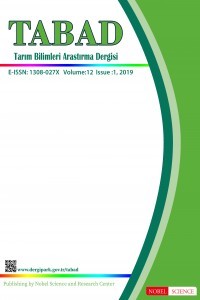Determination of Suitable Solvents for Extraction of Different Fruit Parts of Bitter Melon (Momordica charantia L.)
Determination of Suitable Solvents for Extraction of Different Fruit Parts of Bitter Melon (Momordica charantia L.)
This study was conducted to determine suitable solvents in regard to extract rate for extraction of different parts of ripe and unripe fruits in bitter melon (Momordica charantia L.) grown in Pazar/Rize conditions in the Black Sea Region. The fruit parts of the plant were separately assessed for extraction with solvents, methanol, ethanol and hexane. The extract values (g/g) obtained by solvent extraction in 2014 were determined as percentage. Significant differences were found on the performance of solvents used in extraction depending on the ripeness condition of fruits. Among the fruit sections, the highest (p<0.01) extract rate was obtained from seed coat of ripe fruits through methanolic (73.7 %) and ethanolic (68.5 %) extraction. On the other hand, for the seed coat of unripe fruits, the highest extract rate (16.9 %) was determined in only methanolic extraction. The highest extract rate was obtained from ethanol with 35.1 % (P<0.01) for seeds of ripe fruits. On the other hand, the highest extract rate (p<0.05) for seeds of unripe fruits was obtained with methanol and hexane, 27.7 % and 21.3 % respectively. Methanol was the best one (p<0.01) among the solvents used in extraction of fleshy parts of both ripe and unripe fruits, and extract rates occurred as 41.3 % and 34.8 % respectively. The results obtained from the study showed that, among the solvents for high extract yield, ethanol could be used for extraction of ripe seed and methanol for other fruit sections
Keywords:
Fruit sections extract rate, seed coat,
- Başlangıç: 2008
- Yayıncı: Nobel Bilim ve Araştırma Merkezi Limited
Sayıdaki Diğer Makaleler
Sinem Öztürk ERDEM, Çetin ÇEKİÇ
Tuz Stresinin Ayçiçeğinin (Helianthus annuus L.) Fide Gelişimi Üzerine Etkisi
Ousmane SADOU, Murat AYCAN, Mehdi TAHER, Mustafa KAYAN, Mustafa YILDIZ
Nurdilek GÜLMEZOĞLU, İnci TOLAY
The Efficacy of Harpin (Messenger Gold) on Fruit Set and Fruit Quality on ‘0900 Ziraat’ Sweet Cherry
Erdal AĞLAR, Onur SARAÇOĞLU, Kenan YILDIZ, Şirin HAS
Biogas Production Potential of Solid Wastes: A Research Experience
Hakan POLATCI, Muhammed TAŞOVA, Ali KASAP, Mehmet YÜKSEL
Sibel Ölmez CANGİ, Rüstem CANGİ, Duran KILIÇ, Tuba BEKAR
Effects of Pruning Intensity on Grape Yield and Quality of Erciş Grape Cultivar (Vitis vinifera L.)
